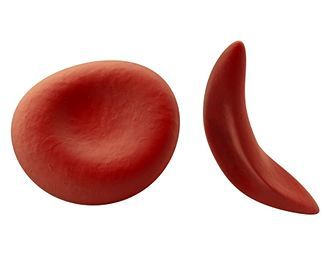A majority of the sickle cell anemia symptoms arise out of abnormally shaped red blood cells which have a sickle appearance. They impede blood circulation through the tissues which are hence damaged due to lack of oxygen. The damaged organs and tissues may lead to severe disability in patients who suffer from sickle cell anemia.
The patient goes through periods of recurring crises of differing severity and frequency, on the basis of the movement of the organs. The characteristics of this disease include:
 Pain crisis
Pain crisis- Anemia and fatigue
- Arthritis and dactylitis (inflammation of the feet and hands)
- Liver congestion and splenic sequestration (abrupt pooling of blood in the spleen)
- Bacterial infection
- Heart and lung injury
- Bone infarcts (death of certain areas of the bones) and aseptic necrosis
- Eye damage
- Ulcers in the leg
While certain symptoms like pain crisis, anemia, exhaustion, and bone infarcts may affect people of any age group, others may be specific to certain age brackets. Generally, the symptoms of sickle cell anemia occur in the initial year of a person’s life. Infants and kids can suffer from abdominal pain, fever, aching swelling of the feet and hands (dactylitis), splenic sequestration and pneumococcal bacterial infection.
Adolescents may develop aseptic necrosis, eye damage and leg ulcers. The symptoms in adults are reflected in muscle, organ or bone injury.
The affected infants do not demonstrate sickle cell anemia symptoms in the initial months of their life. This is because the hemoglobin which is produced by the developing fetus or fetal hemoglobin prevents the RBC from sickling. This hemoglobin does not occur in the RBC which is produced after birth so that by the time the infant is 5 months old, the sickling grows prominent and symptoms start showing.
The prognosis of sickle cell anemia is done on the basis of the symptoms present in the patient. Treatment generally aims to manage and prevent the acute manifestations of the ailment, along with blocking of the red blood cells from coagulating. The anemia cannot be reversed with the help of a single remedy. Hence, it is important for family members to understand the illness and communicate with the medical professionals.
Following are the common sickle cell anemia symptoms:
1. Anemia and Fatigue
The chronic nature of sickle cell anemia leads to fatigue. The sickled RBC tends to rupture which shortens the life span of these cells. Generally, the bone marrow strives to consistently produce the red blood cells to make up for their destruction. At times, the bone marrow can suddenly stop RBC production, leading to an aplastic crisis which is often caused by flu and stomach and bowel viruses. If the level of hemoglobin drops severely, a blood transfusion may be required.
2. Pain Crisis
These are intermittent painful sickle cell anemia symptoms which are caused due to inadequate supply of blood to the tissues. The impaired circulation is the result of blocking of blood vessels due to the sickling of the RBC.
The sickled cells impede the blood flow which causes intense pain necessitating hospitalization and narcotic medicines. Often, the bones are affected. Clotrimazole and magnesium are administered along with the medicine hydroxyurea.
3. Arthritis and Dactylitis
Inflamamtion and swelling of the hands and feet is generally indicative of sickle cell anemia. Dactylitis or the swelling of hands and feet is resulted by injury to the bones through insufficient blood circulation. It is common in infants. Arthritis or joint inflammation is common in adults. These can be tackled by anti inflammation medication like aspirin and ibuprofen.
4. Bacterial Infections
Pneumonia or lung infection commonly affects children and leads to hospitalization. Antibiotics may not immediately work. Children affected by sickle cell anemia may be prone to meningitis and osteomyelitis, which is a rare bone infection.
5. Liver Congestion and Splenic Sequestration
The spleen and liver are active components in eliminating the sickled RBC. Splenic sequestration may lead to severe anemia and even death. Infants may experience an enlarged spleen that can shrink with scarring from poor circulation. This increases the chances of a bacterial infection. If the patient develops a shock and becomes unconscious, blood transfusion may be necessary.
6. Lung and Heart Injury
Areas of dead tissue can lead to a damaged lung. These local areas are called pulmonary infarcts which require special X-rays. Infants also experience an enlarged heart. These sickle cell anemia symptoms can be treated with oxygen supplements.




